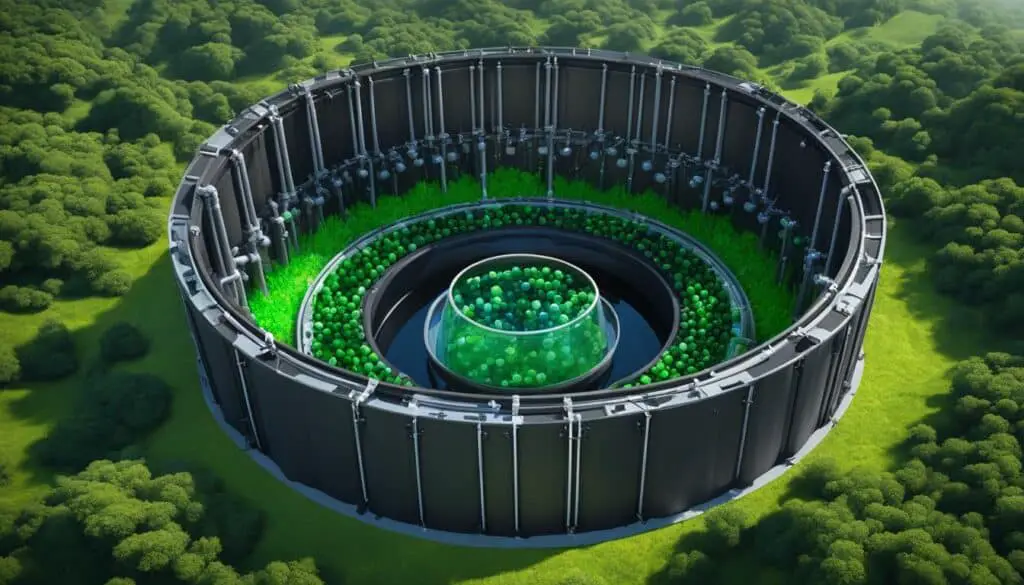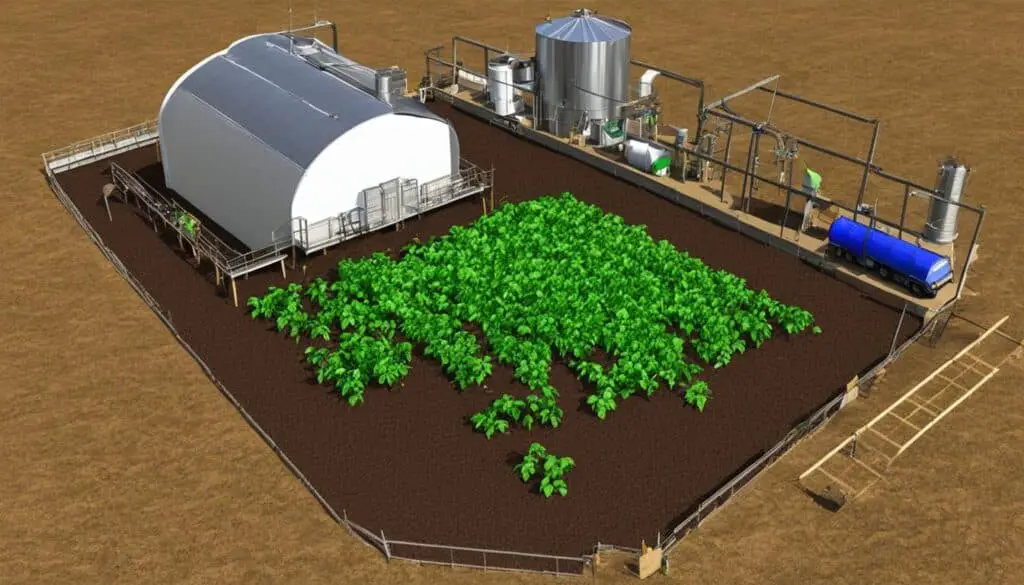
The Rise of Hydrogen Fuel Cell Vehicles
Hydrogen fuel cell vehicles are poised to revolutionize the future of transportation. As governments around the world set ambitious climate goals and the urgency to reduce greenhouse gas emissions intensifies, hydrogen fuel cell vehicles offer a potential solution towards achieving a more sustainable future. These vehicles utilize hydrogen as a clean and renewable source of energy, emitting only water vapor as a byproduct.
With their zero-emission profile and longer driving range compared to traditional electric vehicles, hydrogen fuel cell vehicles hold great promise in addressing the environmental challenges of the automotive industry. With further investment and policy support, these vehicles can play a crucial role in decarbonizing the transportation sector.
Key Takeaways:
- Hydrogen fuel cell vehicles are emerging as a sustainable solution for the future of transportation.
- They utilize hydrogen as a clean and renewable source of energy, emitting only water vapor.
- These vehicles offer a longer driving range compared to traditional electric vehicles.
- Further investment and policy support are needed to achieve widespread adoption.
- Hydrogen fuel cell vehicles have the potential to decarbonize the transportation sector and contribute to a greener future.
The Role of Anaerobic Digestion in Methane Reduction
Anaerobic digestion (AD) plays a crucial role in reducing methane emissions and contributing to a more sustainable future. This process not only helps mitigate the harmful effects of methane, a potent greenhouse gas but also produces renewable natural gas (RNG) and valuable byproducts.
In New York, organic waste is responsible for a significant portion of the state’s greenhouse gas emissions, with methane being a major contributor. By implementing AD technology and building digesters, New York has the potential to make substantial progress in methane reduction.
According to a report, even starting with just 30 new AD facilities in New York could result in a 90% reduction in landfill methane releases and an overall 11.2% decrease in emissions by 2030. The benefits are clear, not only in terms of methane reduction but also in terms of economic opportunities.
“AD infrastructure has the potential to create new jobs and attract capital investment,” explains Dr. Jane Johnson, a leading environmental scientist.
Scaling up AD operations nationwide would require further advancements and crucial policy support. By increasing AD infrastructure and promoting the use of renewable natural gas, municipalities can continue to reduce methane emissions and move towards a more sustainable and environmentally friendly future.
Advancements in Anaerobic Digestion Technology
The technology behind anaerobic digestion has seen significant advancements, resulting in improved carbon-to-methane conversion and higher emissions capture rates. Over the years, the industry has made great strides in enhancing the efficiency of the conversion process, increasing it from 30-35% to an impressive 65-70%. This improvement enables a more effective conversion of organic waste into valuable biogas.
Another area of progress is the emissions capture rate, which stands at an astounding 99.9%. This means that almost all of the methane released during the anaerobic digestion process is captured, reducing its potential impact on the environment and maximizing the energy potential of biogas.
However, anaerobic digestion systems alone may not be able to handle the diverse range of organic materials and often leave behind residual digestate solids. To tackle this challenge and further reduce methane emissions, composting has emerged as a complementary technology. Composting helps in the decomposition of organic matter, eliminating potential methane emissions and producing valuable compost that can be used for soil enrichment.
For larger anaerobic digestion operations, alternative methods such as pyrolysis or gasification may be more suitable for converting solids and carbon into various products. These methods offer additional avenues for utilizing the byproducts of anaerobic digestion and achieving a more comprehensive and sustainable waste management system.
“The technology behind anaerobic digestion has seen significant advancements, resulting in improved carbon-to-methane conversion and higher emissions capture rates.”
The Benefits of Advancements in Anaerobic Digestion Technology
- Higher conversion efficiency: With improved carbon-to-methane conversion rates, anaerobic digestion systems can generate more biogas from organic waste, maximizing energy production and reducing the need for fossil fuels.
- Reduced greenhouse gas emissions: The impressive emissions capture rate of 99.9% ensures that anaerobic digestion effectively minimizes methane emissions, a potent greenhouse gas.
- Composting for enhanced sustainability: Composting complements anaerobic digestion by diverting organic waste from landfills, reducing methane emissions, and producing valuable compost for agricultural use.
- Diverse application possibilities: Large-scale anaerobic digestion operations can explore alternative technologies like pyrolysis and gasification to convert digestate solids and carbon into various products, opening up opportunities for resource recovery.

| Advancements | Carbon-to-Methane Conversion | Emissions Capture Rate |
|---|---|---|
| Previous | 30-35% | N/A |
| Current | 65-70% | 99.9% |
The Role of AD in the Agriculture Sector
The agriculture sector, particularly dairy farms, is increasingly turning to anaerobic digestion to manage manure more sustainably and reduce their carbon footprint. By providing manure as a feedstock for AD, dairy farmers can generate extra income and significantly cut methane emissions.
In New York, bringing around 260 new AD systems to dairy farms could reduce methane from manure by 56.5%. This reduction in methane emissions plays a crucial role in mitigating the greenhouse effect and addressing climate change concerns.
To further enhance the sustainability of AD in the agriculture sector, researchers are focusing on developing cost-effective treatments to increase the biodegradability and biogas production rate of manure. By optimizing the digestion process, dairy farmers can maximize the potential energy yield from their manure while minimizing waste.
Automation advancements are also being explored to streamline and optimize the AD process on dairy farms. This includes automated feeding systems, monitoring and control systems, and smart technologies to enhance efficiency and productivity.
Maximizing the Benefits of AD in Dairy Farms
In addition to improvements in manure management and methane reduction, the agriculture sector is exploring innovative solutions to maximize the benefits of AD. One such approach is the use of perennial grasses as feedstock, alongside manure, to enhance biogas production. Perennial grasses can provide a sustainable and renewable source of biomass, further reducing dependency on fossil fuels.
Other emerging technologies, such as co-digestion and nutrient recovery, are also being investigated to optimize AD on dairy farms. Co-digestion involves the addition of multiple organic waste streams, such as food waste or crop residues, to the AD process. This not only diversifies the feedstock but also increases biogas production and enhances the overall sustainability of the system.
“Anaerobic digestion plays a crucial role in transforming dairy farming into a more sustainable and environmentally friendly practice. By managing manure through AD, dairy farmers can not only reduce their carbon footprint but also generate valuable biogas and nutrient-rich digestate that can be used as fertilizer.”
With ongoing research and technological advancements, the agriculture sector is poised to unlock even greater potential for biogas production and environmental sustainability through anaerobic digestion. By adopting these innovative solutions, dairy farms can contribute to a circular economy, reduce reliance on non-renewable resources, and play a significant role in combating climate change.

The Benefits of AD in Dairy Farms:
| Benefits | Explanation |
|---|---|
| Reduced Methane Emissions | The use of anaerobic digestion significantly reduces methane emissions from manure, minimizing the environmental impact of dairy farming. |
| Extra Income Generation | By utilizing AD technology, dairy farmers can generate additional income by selling the produced biogas or utilizing it for their own energy needs. |
| Renewable Energy Production | AD converts manure into biogas, a renewable energy source that can be used for electricity, heat, or vehicle fuel. |
| Nutrient Recovery | The digestate produced through AD contains valuable nutrients that can be used as organic fertilizer, reducing the need for chemical fertilizers. |
| Waste Management | AD provides an efficient solution for managing manure, minimizing odor emissions and improving overall waste management on dairy farms. |
Policy and Regulatory Support for AD Infrastructure
To fully realize the potential of anaerobic digestion (AD) and AD infrastructure, policy and regulatory support are essential. Shifting to a lifecycle carbon accounting approach that considers the entire lifecycle of fuels, including their production and end-use, would provide the necessary investment certainty for AD infrastructure. This means taking into account the carbon emissions associated with the production, transportation, and use of fuels, enabling informed decision-making and incentivizing sustainable alternatives.
Furthermore, recognizing the climate and air quality benefits of biogas, clean fuel standards at the state level could play a crucial role in promoting the production and use of low-carbon transportation fuels, including biogas. These standards would establish requirements for the quality and carbon intensity of fuels, encouraging the adoption of cleaner alternatives and reducing greenhouse gas emissions.
State policymakers, such as New York State Senator Sean M. Ryan, are already advocating for the adoption of AD as a key solution to meet climate goals and drive economic growth. With their support, implementing favorable policy frameworks, including lifecycle carbon accounting and clean fuel standards, becomes a viable strategy to accelerate the development of AD infrastructure and create a sustainable future.
Investment certainty, along with supportive policies and regulations, is crucial for attracting private and public investments in AD infrastructure and ensuring long-term viability. By providing a clear and stable environment, policymakers can instill confidence among potential investors, catalyzing the growth and expansion of AD projects.
In summary, policy and regulatory support are pivotal in unlocking the full potential of AD infrastructure. Adopting a lifecycle carbon accounting approach and implementing clean fuel standards can provide the investment certainty required for the development and expansion of AD projects. By working together, policymakers, industry stakeholders, and environmental advocates can create an environment conducive to sustainable solutions and a greener future.
Conclusion
The potential of hydrogen fuel cell vehicles to revolutionize the automotive industry and contribute to a sustainable future is significant. By utilizing anaerobic digestion (AD) technology, we can effectively reduce methane emissions, paving the way for the achievement of ambitious climate goals.
The continuous advancements in AD technology, such as improved carbon-to-methane conversion and higher emissions capture rates, are driving progress in methane reduction. However, to fully realize the potential of hydrogen fuel cell vehicles and AD infrastructure, we need strong policy and regulatory support.
It is crucial to adopt comprehensive measures like lifecycle carbon accounting and clean fuel standards to incentivize investments and ensure a sustainable future. By implementing the right policies and providing the necessary support, we can create a greener transportation system and effectively combat climate change through the widespread adoption of hydrogen fuel cell vehicles.
FAQ
What are hydrogen fuel cell vehicles?
Hydrogen fuel cell vehicles are vehicles that use hydrogen gas as fuel to produce electricity, which powers the vehicle’s electric motor. They are considered a promising solution for sustainable transportation due to their zero-emission nature and potential to reduce greenhouse gas emissions.
How do hydrogen fuel cell vehicles contribute to a greener future?
Hydrogen fuel cell vehicles contribute to a greener future by emitting only water vapor as exhaust, resulting in zero emissions of harmful pollutants. They have the potential to reduce greenhouse gas emissions and improve air quality, helping to combat climate change and create more sustainable transportation systems.
What is anaerobic digestion (AD) technology?
Anaerobic digestion (AD) technology is a process that converts organic waste into renewable natural gas (RNG) and other valuable byproducts. It involves breaking down organic matter in the absence of oxygen, resulting in the production of biogas that can be used as a low-carbon fuel source.
How does AD technology reduce methane emissions?
AD technology reduces methane emissions by capturing and utilizing the methane produced during the decomposition of organic waste. Methane is a potent greenhouse gas, and AD technology helps to prevent its release into the atmosphere, thereby reducing its contribution to global warming.
What are the advancements in AD technology?
Advancements in AD technology include improving the carbon-to-methane conversion efficiency and emissions capture rates. Over the years, the industry has achieved conversion efficiency rates of 65-70% and emissions capture rates of 99.9%, making the AD process more efficient and effective in reducing methane emissions.
How is composting related to AD technology?
Composting is a complementary technology to AD that helps in handling the solid residues left behind after the organic waste has been processed through AD. Composting further reduces methane emissions and provides an additional method for managing organic waste in a sustainable manner.
How does AD benefit the agriculture sector, specifically dairy farms?
AD benefits the agriculture sector, particularly dairy farms, by providing a sustainable solution for manure management. By using manure as a feedstock for AD, dairy farmers can not only reduce methane emissions but also generate renewable energy in the form of biogas, thereby reducing their carbon footprint while creating additional income.
What policy and regulatory support are needed for AD infrastructure?
Policy and regulatory support for AD infrastructure include adopting a lifecycle carbon accounting approach that considers the entire lifecycle of fuels, implementing clean fuel standards at the state level to incentivize the production and use of low-carbon transportation fuels, and providing investment certainty for AD infrastructure development.
What is the potential of hydrogen fuel cell vehicles?
Hydrogen fuel cell vehicles have the potential to revolutionize the automotive industry and contribute to a sustainable future by reducing greenhouse gas emissions and improving air quality. They offer a zero-emission alternative to traditional gasoline and diesel-powered vehicles, paving the way for a greener transportation system.
Why is policy support important for hydrogen fuel cell vehicles?
Policy support is crucial for hydrogen fuel cell vehicles as it creates a supportive environment for their adoption and widespread usage. Policies such as incentives, infrastructure development, and clean fuel standards can drive the growth of hydrogen fuel cell vehicles and pave the way for a more sustainable and cleaner transportation future.
